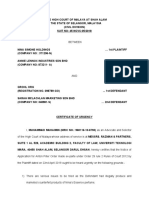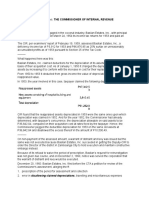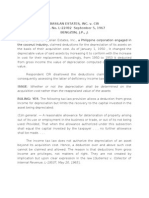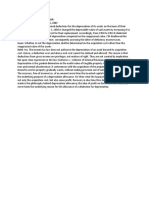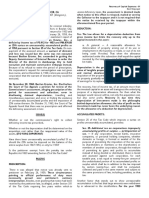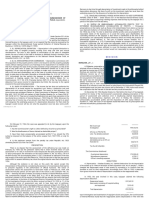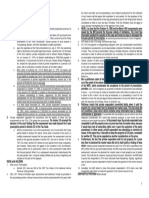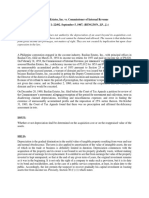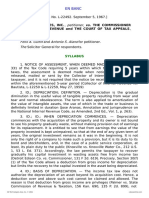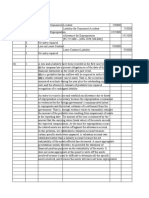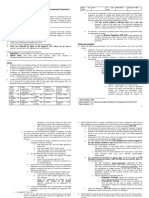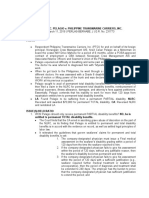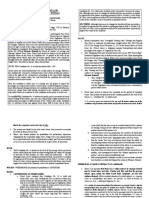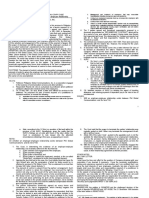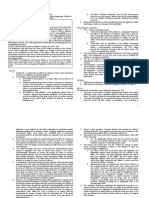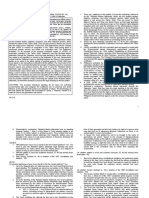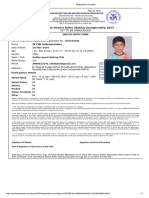0 ratings0% found this document useful (0 votes)
33 views60 Basilan Estates v. CIR
60 Basilan Estates v. CIR
Uploaded by
luigi vidaBasilan Estates was assessed by the CIR for deficiency income tax for 1953. It deducted depreciation on reappraised asset values rather than acquisition costs. The CTA upheld the CIR's assessment. The Supreme Court ruled that:
1) Depreciation must be calculated based on acquisition cost, not reappraised values, as the law does not authorize deductions beyond acquisition cost.
2) The CIR properly disallowed the excess depreciation amount but Basilan was allowed deductions for travelling and miscellaneous expenses.
3) Basilan was liable for deficiency income tax and surtax on accumulated profits as determined by the CIR and upheld by the CTA.
Copyright:
© All Rights Reserved
Available Formats
Download as DOCX, PDF, TXT or read online from Scribd
60 Basilan Estates v. CIR
60 Basilan Estates v. CIR
Uploaded by
luigi vida0 ratings0% found this document useful (0 votes)
33 views3 pagesBasilan Estates was assessed by the CIR for deficiency income tax for 1953. It deducted depreciation on reappraised asset values rather than acquisition costs. The CTA upheld the CIR's assessment. The Supreme Court ruled that:
1) Depreciation must be calculated based on acquisition cost, not reappraised values, as the law does not authorize deductions beyond acquisition cost.
2) The CIR properly disallowed the excess depreciation amount but Basilan was allowed deductions for travelling and miscellaneous expenses.
3) Basilan was liable for deficiency income tax and surtax on accumulated profits as determined by the CIR and upheld by the CTA.
Original Description:
60 Basilan Estates v. CIR
Copyright
© © All Rights Reserved
Available Formats
DOCX, PDF, TXT or read online from Scribd
Share this document
Did you find this document useful?
Is this content inappropriate?
Basilan Estates was assessed by the CIR for deficiency income tax for 1953. It deducted depreciation on reappraised asset values rather than acquisition costs. The CTA upheld the CIR's assessment. The Supreme Court ruled that:
1) Depreciation must be calculated based on acquisition cost, not reappraised values, as the law does not authorize deductions beyond acquisition cost.
2) The CIR properly disallowed the excess depreciation amount but Basilan was allowed deductions for travelling and miscellaneous expenses.
3) Basilan was liable for deficiency income tax and surtax on accumulated profits as determined by the CIR and upheld by the CTA.
Copyright:
© All Rights Reserved
Available Formats
Download as DOCX, PDF, TXT or read online from Scribd
Download as docx, pdf, or txt
0 ratings0% found this document useful (0 votes)
33 views3 pages60 Basilan Estates v. CIR
60 Basilan Estates v. CIR
Uploaded by
luigi vidaBasilan Estates was assessed by the CIR for deficiency income tax for 1953. It deducted depreciation on reappraised asset values rather than acquisition costs. The CTA upheld the CIR's assessment. The Supreme Court ruled that:
1) Depreciation must be calculated based on acquisition cost, not reappraised values, as the law does not authorize deductions beyond acquisition cost.
2) The CIR properly disallowed the excess depreciation amount but Basilan was allowed deductions for travelling and miscellaneous expenses.
3) Basilan was liable for deficiency income tax and surtax on accumulated profits as determined by the CIR and upheld by the CTA.
Copyright:
© All Rights Reserved
Available Formats
Download as DOCX, PDF, TXT or read online from Scribd
Download as docx, pdf, or txt
You are on page 1of 3
60 Basilan Estates Inc. v. CIR (Aguirre) 4.
On non-payment of such amount, a warrant of distraint and levy was
September 5, 1967 | Bengzon, J.P, J. | Depreciation issued but the same was not executed because Basilan Estate succeeded
in getting the Deputy CIR to order the Director of the district in
PETITIONER: Basilan Estates, Inc. Zamboanga City to hold execution and maintain constructive embargo
RESPONDENTS: The Commissioner of Internal Revenue (CIR) and the instead.
CTA 5. Because of its refusal to waive the period of prescription, the
corporation's request for reinvestigation was not given due course, and
SUMMARY: Basilan Estates was assessed by the CIR for deficiency income so in 1960, notice was served that the warrant of distraint and levy would
tax for the year 1953 . It then filed before the CTA a petition for review of be executed.
the CIR’s assessment alleging, among others, that the CIR erred in 6. Basilan then filed before the CTA for review of CIR's assessment,
disallowing the claimed depreciations particularly that — up to 1949, alleging:
deductions for the depreciation of its assets should be on the basis of their a. Prescription of the period of assessment and collection
acquisition cost; and that from 1950-1953: It deducted from gross income i. That it never received notice of such assessment or if
the value of depreciation computed on the reappraised value in light of the it did, it received it beyond the 5 year prescriptive
increase in cost for replacement. The CIR contends that the reappraised period.
assets depreciated in 1953 were the same ones upon which depreciation was b. Error in Reappraised
disallowingassets
claimed depreciations, travelling
47.342.53 and
claimed in 1952, which is the deductible depreciation was pegged on the New Assets: Hospital building
miscellaneous expenses. It claimed that— + Equipment 3,910.45
acquisition cost. The issue is WoN depreciation shall be determined on the i. Up to 1949: Deductions for the depreciation
TOTAL DEPRECIATION 51,252.98of its
acquisition cost or on the reappraised value of the assets? —Acquisition cost. assets should be on the basis of their acquisition cost;
and that
Depreciation is the gradual diminution in the useful value of tangible ii. As of January 1, 1950: It changed the depreciable
property resulting from wear and tear and normal obsolescence. It value of said assets by increasing it to conform with
commences with the acquisition of the property. The income tax law does not the increase in cost for their replacement
authorize the depreciation of an asset beyond its acquisition cost. Hence, a iii. 1950-1953: It deducted from gross income the value of
deduction over and above such cost cannot be claimed and allowed. The depreciation computed on the reappraised value.
reason is that deductions from gross income are privileges, not matters of
right. They are not created by implication but upon clear expression in the
law. The recovery, free of income tax, of an amount more than the invested
capital in an asset will transgress the underlying purpose of a depreciation
allowance. c. Error in finding the existence of unreasonably accumulated
profits and the imposition of 25% surtax thereon.
DOCTRINE: The income tax law does not authorize the depreciation of an 7. The CTA found that there was no prescription and affirmed the
asset beyond its acquisition cost. Hence, a deduction over and above such assessment
cost cannot be claimed and allowed. 8. Hence, this appeal.
9. NOTE: Upon examination of taxpayer's books and papers, the CIR
FACTS: found that the reappraised assets depreciated in 1953 were the same
1. Basilan Estates, Inc. is a Philippine corporation engaged in coconut ones upon which depreciation was claimed in 1952.
industry with principal offices in Basilan City. a. And for the year 1952, the CIR had already determined the
2. It filed in 1954 its income tax returns for 1953 and paid P8,028. depreciation to be P36,842.04, computed on their acquisition
3. Per examiner's report of Feb. 19, 1959, the CIR then assessed Basilan on cost at rates fixed by the taxpayer. Hence, the CIR pegged the
Feb. 26, 1959: deductible depreciation for 1953 on the same old assets at
a. P3,912 as deficiency income tax for 1953 and P36,842.04 and disallowed the excess of P10,500.49.
b. P86,867.85 as 25% surtax on unreasonably accumulated profits
as of 1953 pursuant to Section 25 of the Tax Code. ISSUE:
1. MAIN: WoN depreciation shall be determined on the acquisition cost or beyond its acquisition cost. Hence, a deduction over and above such cost
on the reappraised value of the assets? —Acquisition cost. cannot be claimed and allowed.
a. NOTE: On WoN the CIR’s disallowance of items which Basilan a. The reason is that deductions from gross income are privileges,
claimed as deductible was proper — Partially granted. not matters of right. They are not created by implication but
i. Depreciation: CIR was correct. upon clear expression in the law.
ii. Other expenses: Taxpayer was correct. 5. The recovery, free of income tax, of an amount more than the invested
2. WoN the CIR's right to collect deficiency income tax prescribed? NO capital in an asset will transgress the underlying purpose of a
3. WoN there were unreasonably accumulated profits? YES depreciation allowance.
4. WoN the Basilan is exempt from the penalty tax? NO a. For then what the taxpayer would recover will be, not only the
acquisition cost, but also some profit.
RULING: The judgment appealed from is modied to the extent that Basilan is b. Recovery in due time through depreciation of investment made
allowed its deductions for travelling and miscellaneous expenses, but affirmed is the philosophy behind depreciation allowance; the idea of
insofar as the Basilan is liable for P2,100.67 as 25% deficiency income tax for 1953 profit on the investment made has never been the underlying
and P86,876.75 as 25% surtax on the unreasonably accumulated profit. reason for the allowance of a deduction for depreciation.
6. Accordingly, the claim for depreciation beyond P36,842.04 or in the
RATIO: amount of P10,500.49 has no justification in the law. The determination,
First Issue: Depreciation & Expenses of the CIR disallowing said amount, affirmed by the CTA, is sustained.
Depreciation
1. Depreciation is the gradual diminution in the useful value of tangible Expenses
property resulting from wear and tear and normal obsolescence. 1. CIR: disallowed because the nature of these expenses could not be
a. applied to amortization of the value of intangible assets, the use satisfactorily explained nor be supported by appropriate papers.
of which in the trade or business is definitely limited in 2. Basilan: Gulfin, the accountant, explained that the (misc.) actual
duration. expenses were incurred during the president's trip to Manila, and fo the
2. Depreciation commences with the acquisition of the property and its president's travelling expenses; as to the vouchers and receipts of these,
owner is not bound to see his property gradually waste, without making he said the same were made but got burned during the Basilan fire on
provision out of earnings for its replacement. March 30, 1962.
a. It is entitled to see that from earnings the value of the property 3. The papers in support of these miscellaneous and travelling expenses
invested is kept unimpaired, so that at the end of any given term were not included for the reason that by February 9, 1959, when the BIR
of years, the original investment remains as it was. decided to investigate, Basilan had no more obligation to keep the same
b. It is not only the right of a company to make such a provision, since 5 years had lapsed from the time these expenses were incurred
but it is its duty to its bond and stockholders, and, in the case of 4. SC: Receipts and papers supporting such expenses need be kept by the
a public service corporation, at least, its plain duty to the public. taxpayer for a period of 5 years from the last entry. At the time of the
3. Accordingly, the law permits the taxpayer to recover gradually his investigation, said 5 years had lapsed.
capital investment in wasting assets free from income tax.
a. Section 30 (f) (1) states: “A reasonable allowance for Second Issue: Prescription
deterioration of property arising out of its use…in the business 1. Not prescribed— considering the presence of circumstances that lead Us
or trade, or out of its not being used: Provided, that when the to presume regularity in the performance of official functions.
allowance authorized under this subsection shall equal the 2. The notice of assessment shows the assessment to have been made on
capital invested by the taxpayer…no further allowance shall be February 26, 1959, well within the 5 year period. On the right side of
made…” the notice is also stamped "Feb. 26, 1959" — denoting the date of release,
b. This allows a deduction from gross income for depreciation but according to BIR practice. The CIR in his letter answering Basilan's
limits the recovery to the capital invested in the asset being request to lift the warrant, asserts that notice had been sent to Basilan.
depreciated.
4. The income tax law does not authorize the depreciation of an asset Third Issue: Unreasonably Accumulated Profits
1. The CIR found that in violation Sec, 25, petitioner had unreasonably
accumulated profits as of 1953 of P347,507.01.
2. There was no error in the process applied. Previous accumulations
should be considered in determining unreasonable accumulations for
the year, since accumulations prior to the year involved may have been
sufficient to cover the business needs.
3. Also, large amounts were advanced to the stockholders. These advances
were in fact indirect loans to the stockholders indicating the
unreasonable accumulation of surplus beyond the needs of the business.
Fourth Issue: Alleged Exemption
1. Basilan wishes to avail of the exempting proviso in Sec. 25 of the NIRC
as amended, approved June 27, 1957, whereby accumulated profits or
surplus if invested in any dollar-producing/earning industry or in the
purchase of bonds issued by the Central Bank may not be subject to the
25% surtax.
2. Here, the unreasonable accumulation was in 1953. The exemption was
by virtue of RA 1823 which amended Sec. 25 only on June 22, 1957 —
more than 3 years after.
You might also like
- MIN-320 Topic 2 Spiritual Practices: Spiritual Discipline Biblical Support Real Life ApplicationDocument3 pagesMIN-320 Topic 2 Spiritual Practices: Spiritual Discipline Biblical Support Real Life ApplicationnadiaNo ratings yet
- Project Management in Practice Third EdDocument1 pageProject Management in Practice Third Edyulianto.pjbNo ratings yet
- Certificate of UrgencyDocument4 pagesCertificate of UrgencySiti Nazatul MurnirahNo ratings yet
- Ritual of The Order of KnighthoodDocument20 pagesRitual of The Order of KnighthoodCristian Cristi100% (1)
- Hinds County Detention Center Monitor ReportDocument13 pagesHinds County Detention Center Monitor ReportKayode CrownNo ratings yet
- Araling Panlipunan 8: Quarter 1 - Module 2 Heograpiyang PantaoDocument26 pagesAraling Panlipunan 8: Quarter 1 - Module 2 Heograpiyang PantaoMher Buenaflor81% (16)
- Basilan V CIRDocument2 pagesBasilan V CIRReinier Jeffrey AbdonNo ratings yet
- 164.basilan Estates Vs CIRDocument7 pages164.basilan Estates Vs CIRClyde KitongNo ratings yet
- Basilan Estates Inc. v. CIR No. 32Document2 pagesBasilan Estates Inc. v. CIR No. 32David ValenciaNo ratings yet
- Basilan Estates vs. CirDocument1 pageBasilan Estates vs. CirLizzy WayNo ratings yet
- Basilan Estates, Inc. vs. Commissioner of Internal Revenue, 21 SCRA 17, September 05, 1967Document14 pagesBasilan Estates, Inc. vs. Commissioner of Internal Revenue, 21 SCRA 17, September 05, 1967Jane BandojaNo ratings yet
- Tax Digests Week 4Document15 pagesTax Digests Week 4Beatrice C. AquinoNo ratings yet
- Basilan Estates Inc. v. CIR and CTADocument2 pagesBasilan Estates Inc. v. CIR and CTATon Ton CananeaNo ratings yet
- G.R. No. L-22492 - Basilan Estates, Inc. v. Commissioner of InternalDocument5 pagesG.R. No. L-22492 - Basilan Estates, Inc. v. Commissioner of InternalE SantosNo ratings yet
- 01 Basilan Estate V CIRDocument2 pages01 Basilan Estate V CIRBasil MaguigadNo ratings yet
- G.R. No. L-22492 - Basilan Estates, Inc. v. Commissioner of Internal RevenueDocument5 pagesG.R. No. L-22492 - Basilan Estates, Inc. v. Commissioner of Internal RevenueMegan AglauaNo ratings yet
- CIR Vs BFDocument1 pageCIR Vs BFNikhim CroneNo ratings yet
- Basilan Estates Vs CIRDocument2 pagesBasilan Estates Vs CIRKim Lorenzo Calatrava100% (1)
- Berks Broadcasting Co V CraumerDocument1 pageBerks Broadcasting Co V Craumervmanalo16No ratings yet
- 61 Fernandez Hermanos v. CIRDocument2 pages61 Fernandez Hermanos v. CIRAgus DiazNo ratings yet
- Basilan Estates Vs Cir (1967)Document7 pagesBasilan Estates Vs Cir (1967)RavenFoxNo ratings yet
- BASILAN ESTATES, INC., Petitioner, vs. The Commissioner of Internal Revenue and The Court of Tax AppealsDocument2 pagesBASILAN ESTATES, INC., Petitioner, vs. The Commissioner of Internal Revenue and The Court of Tax AppealsDe Guzman E AldrinNo ratings yet
- Felix A. Gulfin and Antonio S. Alano For Petitioner. Office of The Solicitor General For RespondentsDocument8 pagesFelix A. Gulfin and Antonio S. Alano For Petitioner. Office of The Solicitor General For RespondentsPeeve Kaye BalbuenaNo ratings yet
- Refund of Taxes: in GeneralDocument3 pagesRefund of Taxes: in GeneralAileen Love ReyesNo ratings yet
- GR No. 175188 - CIR V La TondeñaDocument1 pageGR No. 175188 - CIR V La TondeñaCristelle Elaine ColleraNo ratings yet
- 7 CIR V PhoenixDocument1 page7 CIR V PhoenixFrancesca Isabel MontenegroNo ratings yet
- Tax Basilan Vs CirDocument18 pagesTax Basilan Vs CirairoidNo ratings yet
- 145 Republic v. Lim Tian Teng SonsDocument3 pages145 Republic v. Lim Tian Teng SonsJames LouNo ratings yet
- Basilan Estates Inc V CirDocument9 pagesBasilan Estates Inc V CirPamela GuiangNo ratings yet
- Consolidated Mines Inc. Vs CTADocument1 pageConsolidated Mines Inc. Vs CTAAlyanna Barre100% (2)
- Cir v. Phoenix DigestDocument3 pagesCir v. Phoenix DigestkathrynmaydevezaNo ratings yet
- Latest Jurisprudence and Landmark Doctrines On DepreciationDocument2 pagesLatest Jurisprudence and Landmark Doctrines On DepreciationCarlota Nicolas VillaromanNo ratings yet
- IAET Case 3Document10 pagesIAET Case 3HADTUGINo ratings yet
- SC - Basilan Estates v. CIR 5 September 1967Document9 pagesSC - Basilan Estates v. CIR 5 September 1967Bobby Olavides SebastianNo ratings yet
- 2016 Tax 2 Bar Q&ADocument3 pages2016 Tax 2 Bar Q&Achristine100% (1)
- Coral Bay Nickel Vs CIRDocument5 pagesCoral Bay Nickel Vs CIRCJ CasedaNo ratings yet
- CIR Vs Goodrich DigestDocument2 pagesCIR Vs Goodrich DigestLouie Sallador100% (1)
- CIR vs. Phoenix Assurance L-19727Document1 pageCIR vs. Phoenix Assurance L-19727magenNo ratings yet
- Basilan Estate Vs CirDocument7 pagesBasilan Estate Vs CirpyulovincentNo ratings yet
- Benguet Corp. v. CIR PDFDocument2 pagesBenguet Corp. v. CIR PDFKarla Lois de GuzmanNo ratings yet
- Tax 2 CasesDocument20 pagesTax 2 Casesdulnuan jerusalemNo ratings yet
- Taxation Law 2: B. Income From Any Source WhateverDocument13 pagesTaxation Law 2: B. Income From Any Source WhateverGreggy BoyNo ratings yet
- Debentures and Charges Continued 15.04.2020Document25 pagesDebentures and Charges Continued 15.04.2020Esther DogbeNo ratings yet
- 9.BPI vs. CIRDocument1 page9.BPI vs. CIRBam Bathan100% (1)
- Chapter 4: Securitisation & Reconstruction of Financial Assets and Enforcement of Securities Interest Act, 2002Document3 pagesChapter 4: Securitisation & Reconstruction of Financial Assets and Enforcement of Securities Interest Act, 2002nsk2231No ratings yet
- Lasheras - Fria NotesDocument11 pagesLasheras - Fria NotesMARRYROSE LASHERASNo ratings yet
- In Re) Chapter 11: For The District of Dela WareDocument12 pagesIn Re) Chapter 11: For The District of Dela WareChapter 11 DocketsNo ratings yet
- 12 City of Davao Vs DalisayDocument4 pages12 City of Davao Vs Dalisayanon_614984256No ratings yet
- 04 Basilan Estates Inc. vs. Commissioner of Internal Revenue 21 SCRA 17 September 05 1967Document14 pages04 Basilan Estates Inc. vs. Commissioner of Internal Revenue 21 SCRA 17 September 05 1967DannethGianLatNo ratings yet
- Tax Digest 1Document32 pagesTax Digest 1Marvin CeledioNo ratings yet
- Commissioner of Internal Revenue vs. Vda. de Prieto (1960) : Facts: RatioDocument4 pagesCommissioner of Internal Revenue vs. Vda. de Prieto (1960) : Facts: Ratiojm sanpedroNo ratings yet
- 327-329 Plaridel Surety & Insurance v. CIR Collector v. Goodrich International Rubber Co.Document2 pages327-329 Plaridel Surety & Insurance v. CIR Collector v. Goodrich International Rubber Co.Eloise Coleen Sulla PerezNo ratings yet
- Atlas Consolidated V CirDocument1 pageAtlas Consolidated V CirGyelamagne EstradaNo ratings yet
- TAX1 CasesDocument23 pagesTAX1 CasesbcarNo ratings yet
- Anisa Muzaqi 4C Lat 2 4 Brooks CorporationDocument5 pagesAnisa Muzaqi 4C Lat 2 4 Brooks CorporationAnisaNo ratings yet
- The Impact of the Petroleum Industry Act on Deferred Tax Recognition DecemberDocument7 pagesThe Impact of the Petroleum Industry Act on Deferred Tax Recognition Decemberkhalidbox720No ratings yet
- Refining Company v. CA G.R. No. 118794 May 8, 1996Document10 pagesRefining Company v. CA G.R. No. 118794 May 8, 1996Dani McstNo ratings yet
- Djumantan v. DomingoDocument38 pagesDjumantan v. DomingoHorace CimafrancaNo ratings yet
- Client Briefing January 2010Document7 pagesClient Briefing January 2010api-25889552No ratings yet
- China Bank Vs CA 336 SCRA 179 (Sec 39 Cap Gain/loss) - InganDocument27 pagesChina Bank Vs CA 336 SCRA 179 (Sec 39 Cap Gain/loss) - InganShanielle Qim CañedaNo ratings yet
- 4 Taxation Law EPBDDocument16 pages4 Taxation Law EPBDJohn adaponNo ratings yet
- 01 CIR V BF GoodrichDocument2 pages01 CIR V BF GoodrichChelle BelenzoNo ratings yet
- 12 CIR vs. Phoenix (GR No. L-19727, May 20, 1965)Document13 pages12 CIR vs. Phoenix (GR No. L-19727, May 20, 1965)Alfred GarciaNo ratings yet
- Tax RemediesDocument15 pagesTax RemediesChristopher Jan DotimasNo ratings yet
- April 4estate TaxDocument7 pagesApril 4estate TaxPitongDeAsisNo ratings yet
- Pelagio v. PTCI - 11 March 2019Document2 pagesPelagio v. PTCI - 11 March 2019luigi vidaNo ratings yet
- Cuartocruz v. Active Works Inc - 24 April 2019 - (Hernandez)Document1 pageCuartocruz v. Active Works Inc - 24 April 2019 - (Hernandez)luigi vidaNo ratings yet
- Petitioner vs. vs. Respondents: First DivisionDocument10 pagesPetitioner vs. vs. Respondents: First Divisionluigi vidaNo ratings yet
- Petitioner vs. vs. Respondents: Second DivisionDocument7 pagesPetitioner vs. vs. Respondents: Second Divisionluigi vidaNo ratings yet
- Half Page Digest FormatDocument1 pageHalf Page Digest Formatluigi vidaNo ratings yet
- Finals - Conflicts Digests PDFDocument419 pagesFinals - Conflicts Digests PDFluigi vidaNo ratings yet
- 50 Heirs of Roldan v. Heir of Roldan (JHerm)Document2 pages50 Heirs of Roldan v. Heir of Roldan (JHerm)luigi vidaNo ratings yet
- 238451-2019-Coca-Cola Femsa Philippines v. Macapagal PDFDocument7 pages238451-2019-Coca-Cola Femsa Philippines v. Macapagal PDFluigi vidaNo ratings yet
- 00 TITLE O THE CASE (Surname) OpyDocument1 page00 TITLE O THE CASE (Surname) Opyluigi vidaNo ratings yet
- 35 Sulpicio Lines, Inc. vs. SesanteDocument4 pages35 Sulpicio Lines, Inc. vs. Sesanteluigi vidaNo ratings yet
- 06 Kasilag v. RodriguezDocument3 pages06 Kasilag v. Rodriguezluigi vidaNo ratings yet
- 07 Phil Global Communications v. de Vera (Hernandez)Document2 pages07 Phil Global Communications v. de Vera (Hernandez)luigi vidaNo ratings yet
- 179 Republic v. Capote (JH)Document2 pages179 Republic v. Capote (JH)luigi vidaNo ratings yet
- Col DigestsDocument8 pagesCol Digestsluigi vidaNo ratings yet
- Course Outline in Special Civil ActionsDocument5 pagesCourse Outline in Special Civil Actionsluigi vidaNo ratings yet
- 138 People v. Sope and Cruz (JH)Document1 page138 People v. Sope and Cruz (JH)luigi vidaNo ratings yet
- Situs Does Not Apply.: Personal Law, Nationality and DomicileDocument2 pagesSitus Does Not Apply.: Personal Law, Nationality and Domicileluigi vidaNo ratings yet
- 226 Resident Marine Mammals v. Reyes (JH)Document3 pages226 Resident Marine Mammals v. Reyes (JH)luigi vidaNo ratings yet
- 07 Phil Global Communications v. de VeraDocument2 pages07 Phil Global Communications v. de Veraluigi vidaNo ratings yet
- 60 Saludo, Jr. vs. CADocument6 pages60 Saludo, Jr. vs. CAluigi vidaNo ratings yet
- 81 Crisostomo V NazarenoDocument2 pages81 Crisostomo V Nazarenoluigi vida100% (1)
- 12-Lim V Executive SecretaryDocument3 pages12-Lim V Executive Secretaryluigi vidaNo ratings yet
- Food Safety at Events and FestivalsDocument2 pagesFood Safety at Events and FestivalsSophie-Louise MercedesNo ratings yet
- Amazon Seller VA MasterclassDocument6 pagesAmazon Seller VA MasterclassRechelle CapunoNo ratings yet
- Cplog2020 6 19 5 31 37Document5 pagesCplog2020 6 19 5 31 37Muhammad Irfan FaisalNo ratings yet
- LGC Remedies For Collection of RevenuesDocument5 pagesLGC Remedies For Collection of RevenuesmarmiedyanNo ratings yet
- Niti AayogDocument4 pagesNiti AayogPalak JioNo ratings yet
- Rockwool International A - S VS Thermocare Rockwool (India) Pvt. LTDDocument7 pagesRockwool International A - S VS Thermocare Rockwool (India) Pvt. LTDEmily FosterNo ratings yet
- Title ProposalDocument3 pagesTitle Proposal21-38010No ratings yet
- Disaster Management Project - 2016009Document15 pagesDisaster Management Project - 2016009Akshay LalNo ratings yet
- Art AppreciationDocument27 pagesArt AppreciationRoseMarie Masongsong50% (2)
- The Shock Doctrine: The Rise of Disaster Capitalism By: Naomi KleinDocument3 pagesThe Shock Doctrine: The Rise of Disaster Capitalism By: Naomi KleinRosemarie InojalesNo ratings yet
- Agra To AligarhDocument2 pagesAgra To AligarhpankajNo ratings yet
- Belapur HousingDocument29 pagesBelapur HousingPRATHMESH KAPSENo ratings yet
- Resolution No. 10, S. 2019Document4 pagesResolution No. 10, S. 2019Aina Langcay Daligdig100% (1)
- Puma Global Factory List 2024Document31 pagesPuma Global Factory List 2024hitesh bhatiaNo ratings yet
- Physiology MCQsDocument7 pagesPhysiology MCQsshair adamNo ratings yet
- UFO Crash-Retrievals - Status Reports 1-VII Leaonard StringfieldDocument590 pagesUFO Crash-Retrievals - Status Reports 1-VII Leaonard Stringfieldlogans.proxNo ratings yet
- Sample Paper A2Document8 pagesSample Paper A2Simona Rusu100% (1)
- Cibi SubramaniamDocument1 pageCibi Subramaniamterrorboys823No ratings yet
- Special Moment Frames Dan Special Plate Shear Walls: Studi Perbandingan Perencanaan Bangunan Baja SistemDocument12 pagesSpecial Moment Frames Dan Special Plate Shear Walls: Studi Perbandingan Perencanaan Bangunan Baja SistemjackNo ratings yet
- Fm-Qp-Dilg-As-27-03 - (Ipcr)Document1 pageFm-Qp-Dilg-As-27-03 - (Ipcr)Dino Yoshitsune LagosNo ratings yet
- PT Sprint 2022 (Environment and Ecology)Document92 pagesPT Sprint 2022 (Environment and Ecology)Alok KumarNo ratings yet
- Frigid-Transport Is A Small Refrigerated Shipping ...Document3 pagesFrigid-Transport Is A Small Refrigerated Shipping ...ShahbazNo ratings yet
- Culture NI 3 Your Holidaytheir HomeDocument2 pagesCulture NI 3 Your Holidaytheir HomeJonatan Gárate Aros Hofstadter100% (2)
- International Extradition Guide Hedges FJC 2014Document40 pagesInternational Extradition Guide Hedges FJC 2014Tomi Guisado LitterioNo ratings yet


